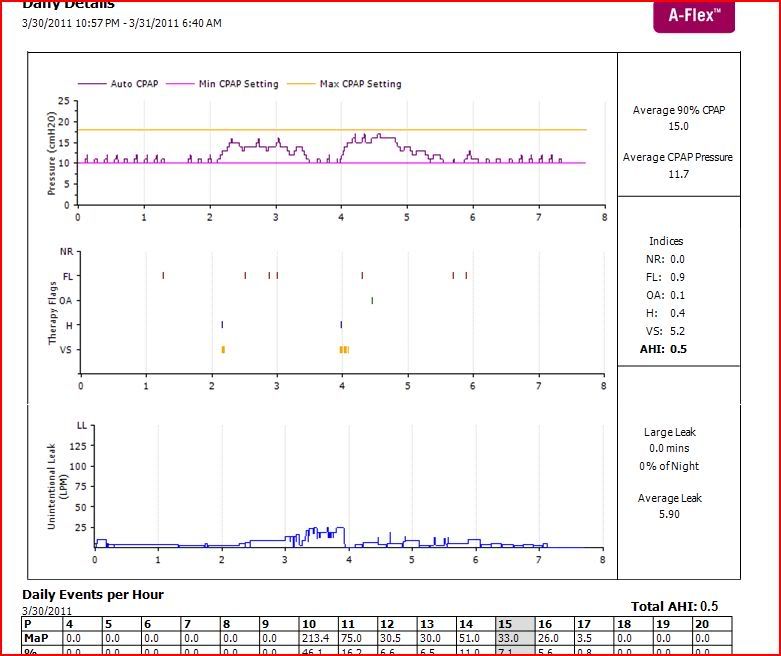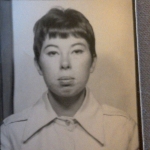Why did you choose Apap over Cpap? Cpap over Apap?
-
quietmorning
- Posts: 1279
- Joined: Wed May 04, 2011 10:39 am
Why did you choose Apap over Cpap? Cpap over Apap?
Why did you choose Apap over Cpap?
Why did you choose Cpap over Apap?
I sleep on Cpap. For me, the biggest part is that I've had two brain injuries and I just never know how my brain is going to react to something. The other part of it is that I'm SUCH an obnoxiously light sleeper that I think the changes in pressure would wake me up a million times more than I already wake up, and I already wake up a LOT.
But every once in a while, I want to try the apap. . .and I may just do that . . .pretty soon. . .
What say you?
Why did you choose Cpap over Apap?
I sleep on Cpap. For me, the biggest part is that I've had two brain injuries and I just never know how my brain is going to react to something. The other part of it is that I'm SUCH an obnoxiously light sleeper that I think the changes in pressure would wake me up a million times more than I already wake up, and I already wake up a LOT.
But every once in a while, I want to try the apap. . .and I may just do that . . .pretty soon. . .
What say you?
- Sheriff Buford
- Posts: 4110
- Joined: Mon Aug 09, 2010 8:01 am
- Location: Kingwood, Texas
Re: Why did you choose Apap over Cpap? Cpap over Apap?
Here we go (lookin' at Pugsy )... I'm only referring to the Resmed S9 Autoset (not Philips Respronics). To me its a comfort thang'. My theory (as been discussed here before, with little objection) is that the Resmed autoset will not start increasing pressure to treat an apnea event until 10 seconds. This allows for yawns, coughs, temporary events that folks hold their breath, etc... Once the machine starts to "ramp-up" during an apnea event, it may take 4-7 seconds to achieve the needed pressure to treat the apnea event. This means your body went thru an apnea event for 11-17 seconds before being treated. My theory is that I didn't feel as well as if the machine was blowing a set rate of air (cpap mode). I've done enough tinkering to accept this for me. Whatever mode you use, I strongly suggest folks to switch to the alternate mode once or twice a year to see how you feel. Everyone is different and the 11-17 second delay the autoset causes does not make a difference in how they feel. To each his own!!
A few months back, I tried the autoset mode and felt better. I stayed on the autoset mode for 3 -4 months. Last week I went back to cpap mode,and didn't feel any difference. I'm still on the cpap mode, but... I seem to like a little more air that the cpap mode offers when I first lie down. If you can see a big difference on how you feel, then by all means stick to the mode that makes you feel better. Most of the time, I can't see a big difference, but that's just me.
Sheriff
A few months back, I tried the autoset mode and felt better. I stayed on the autoset mode for 3 -4 months. Last week I went back to cpap mode,and didn't feel any difference. I'm still on the cpap mode, but... I seem to like a little more air that the cpap mode offers when I first lie down. If you can see a big difference on how you feel, then by all means stick to the mode that makes you feel better. Most of the time, I can't see a big difference, but that's just me.
Sheriff
_________________
| Machine: AirSense 11 Autoset |
| Mask: Mirage Quattro™ Full Face CPAP Mask with Headgear |
Re: Why did you choose Apap over Cpap? Cpap over Apap?
Because there are times that I seem to need a LOT more pressure than what cpap mode fixed pressure will deliver.
It appears to be related to REM stage sleep and that goes along with my history from the sleep studies.
I don't need more more pressure every night and not even all night...just sometimes.
Since pressure changes don't seem to bother me (sleep right through going from 10 to 20) I would rather use lower pressure for part of the night and let the machine increase the pressure as needed for the times that I need more pressure.
So since centrals have never been an issue and pressure changes disturbing sleep have never been an issue, I opt for auto adjusting mode and let the machine do the job it is designed to do.
I can use a fixed pressure mode but I have to make compromises...like do I want to use a lot more pressure all night or do I want to a pressure that works for 75% of the night or do I want to pick a middle of the road pressure that will get all but the most stubborn apnea events?
I actually did use a fixed pressure mode when I got my first bilevel machine just to see how it would do. I used it for about 3 months and did very decently with pressures just a tiny bit more than I used with my APAP machine. Every once in a while I would have a few really ugly clusters sneak past the defenses but for the most part the AHI and quality of my sleep wasn't negatively impacted.
I recently bought a PR S1 BiPap Pro 660 model...fixed bilevel pressures only because I so wanted to try the heated hose thing and waiting to find a 760 in my price range is not someone I have much patience for and since I already knew I could find a suitable compromise with the fixed pressures...I was happy to get what I wanted.
It appears to be related to REM stage sleep and that goes along with my history from the sleep studies.
I don't need more more pressure every night and not even all night...just sometimes.
Since pressure changes don't seem to bother me (sleep right through going from 10 to 20) I would rather use lower pressure for part of the night and let the machine increase the pressure as needed for the times that I need more pressure.
So since centrals have never been an issue and pressure changes disturbing sleep have never been an issue, I opt for auto adjusting mode and let the machine do the job it is designed to do.
I can use a fixed pressure mode but I have to make compromises...like do I want to use a lot more pressure all night or do I want to a pressure that works for 75% of the night or do I want to pick a middle of the road pressure that will get all but the most stubborn apnea events?
I actually did use a fixed pressure mode when I got my first bilevel machine just to see how it would do. I used it for about 3 months and did very decently with pressures just a tiny bit more than I used with my APAP machine. Every once in a while I would have a few really ugly clusters sneak past the defenses but for the most part the AHI and quality of my sleep wasn't negatively impacted.
I recently bought a PR S1 BiPap Pro 660 model...fixed bilevel pressures only because I so wanted to try the heated hose thing and waiting to find a 760 in my price range is not someone I have much patience for and since I already knew I could find a suitable compromise with the fixed pressures...I was happy to get what I wanted.
_________________
| Machine: AirCurve™ 10 VAuto BiLevel Machine with HumidAir™ Heated Humidifier |
| Additional Comments: Mask Bleep Eclipse https://bleepsleep.com/the-eclipse/ |
I may have to RISE but I refuse to SHINE.
Re: Why did you choose Apap over Cpap? Cpap over Apap?
Yes..BUT...if you had the S9 in APAP mode with the minimum pressure set optimally then the chances for that delayed response you are talking about happening....is greatly reduced. APAPs are more about prevention than fixing after the fact. Prevent something from happening in the first place is the goal. None of the APAP machines will do anything once the collapse of the airway has formally occurred...instead they wait till it is over with before they then decide what they need to do..if anything. They respond to impending airway collapse warning signals...snores and flow limitations..that's what they are designed to do. Not to try to "fix" the apnea event that just happened. And yes, sometimes the airway collapses out of the blue without any warning signs...we call them frank apneas. Not much the machine can do about them once they have actually occurred but we can reduce the chance of them ever forming with a little more minimum pressure.Sheriff Buford wrote:Here we go (lookin' at Pugsy )... I'm only referring to the Resmed S9 Autoset (not Philips Respronics). To me its a comfort thang'. My theory (as been discussed here before, with little objection) is that the Resmed autoset will not start increasing pressure to treat an apnea event until 10 seconds
These 2 old reports (not mine BTW) are a perfect example of what setting the minimal pressure at optimal levels will accomplish.
First image is a report with minimum set too low. AHI was still less than 1.0 though.

Second image as to what the pressures do when minimum is set optimally. AHI still the same but by using the higher minimum the pressure never needed to fluctuate nearly as much above 10 cm.

And here is an old one of mine where things were really good except for a couple of probable REM segments where I happened to need a LOT more pressure.

_________________
| Machine: AirCurve™ 10 VAuto BiLevel Machine with HumidAir™ Heated Humidifier |
| Additional Comments: Mask Bleep Eclipse https://bleepsleep.com/the-eclipse/ |
I may have to RISE but I refuse to SHINE.
- chunkyfrog
- Posts: 34545
- Joined: Mon Jul 12, 2010 5:10 pm
- Location: Nowhere special--this year in particular.
Re: Why did you choose Apap over Cpap? Cpap over Apap?
Auto. Tight range. Comfort.
_________________
| Mask: AirFit™ P10 For Her Nasal Pillow CPAP Mask with Headgear |
| Additional Comments: Airsense 10 Autoset for Her |
Re: Why did you choose Apap over Cpap? Cpap over Apap?
I've used both and feel about the same with either mode. With APAP, my pressure settings were 17 to 20 cm (EPR 3) and with CPAP it is 18.4 cm (EPR 3). I don't notice pressure changes of 3 cm while sleeping so APAP was not a problem.
_________________
| Machine: AirSense™ 10 CPAP Machine with HumidAir™ Heated Humidifier |
| Mask: Mirage Quattro™ Full Face CPAP Mask with Headgear |
| Additional Comments: Apap 16 to 18 |
Re: Why did you choose Apap over Cpap? Cpap over Apap?
When I started my Rx listed 5 - 13 changed quickly to 8 -13. After a couple weeks, and with help from Pugsy I had my S9 set to 9 - 15.6 (this was done in stages looking at my 95% pressure).
My 95% then was 14.8 it has since went down to 12.6. I am not sure what is going on, maybe I am sleeping more on my side. Maybe my airway is being exercised by the machine. Point is, who cares, the machine will monitor what I require and deliver that amount of pressure.
The only point I would really like to make about APAP vrs CPAP is that with the APAP you can always set it to deliver a set pressure, with CPAP, you have to change the pressure on your own.
-tino
My 95% then was 14.8 it has since went down to 12.6. I am not sure what is going on, maybe I am sleeping more on my side. Maybe my airway is being exercised by the machine. Point is, who cares, the machine will monitor what I require and deliver that amount of pressure.
The only point I would really like to make about APAP vrs CPAP is that with the APAP you can always set it to deliver a set pressure, with CPAP, you have to change the pressure on your own.
-tino
_________________
| Machine: AirSense™ 10 CPAP Machine with HumidAir™ Heated Humidifier |
| Mask: AirFit™ P10 Nasal Pillow CPAP Mask with Headgear |
| Additional Comments: Autoset Pressure 9-15.6, EPR 1, no ramp |
Tino
- Sheriff Buford
- Posts: 4110
- Joined: Mon Aug 09, 2010 8:01 am
- Location: Kingwood, Texas
Re: Why did you choose Apap over Cpap? Cpap over Apap?
Yes..BUT...if you had the S9 in APAP mode with the minimum pressure set optimally then the chances for that delayed response you are talking about happening....is greatly reduced.
But.... (and I don't know nuthin' about Frank... ), but what has always been in the back of my mind, is that a properly set cpap mode pressure will constantly keep your airways open and autopap will only respond to a "detected" apnea event. I have always had that in the back of my mind but my numbers have never reflected that because they average the same regarless odf using cpap mode or autopap mode.
Sheriff
But.... (and I don't know nuthin' about Frank... ), but what has always been in the back of my mind, is that a properly set cpap mode pressure will constantly keep your airways open and autopap will only respond to a "detected" apnea event. I have always had that in the back of my mind but my numbers have never reflected that because they average the same regarless odf using cpap mode or autopap mode.
Sheriff
_________________
| Machine: AirSense 11 Autoset |
| Mask: Mirage Quattro™ Full Face CPAP Mask with Headgear |
Re: Why did you choose Apap over Cpap? Cpap over Apap?
Many people have pressure needs that vary throughout the night due to the effects of different
sleeping positions or sleep stages. For them, a properly set CPAP requires the use of a higher than
required pressure for parts of the night in order to receive adequate therapy for all of the night.
With a properly set APAP, the minimum pressure is set to meet the user's needs for the majority of
the night. The APAP then increases the pressure only at the times when it is needed.
While APAP algorithms differ from brand to brand (and from different generations within a brand),
they do not respond to events in progress. No machine will attempt to open a collapsed airway.
And APAP algorithms factor in more than just apneas. Events like flow limitations and vibratory snores
often precede apneas and pressure increases to this type of event can allow an APAP
preempt the occurrence of apneas.
Since an APAP can be set to operate as a CPAP, the only disadvantage of an APAP is the additional
cost.
sleeping positions or sleep stages. For them, a properly set CPAP requires the use of a higher than
required pressure for parts of the night in order to receive adequate therapy for all of the night.
With a properly set APAP, the minimum pressure is set to meet the user's needs for the majority of
the night. The APAP then increases the pressure only at the times when it is needed.
While APAP algorithms differ from brand to brand (and from different generations within a brand),
they do not respond to events in progress. No machine will attempt to open a collapsed airway.
And APAP algorithms factor in more than just apneas. Events like flow limitations and vibratory snores
often precede apneas and pressure increases to this type of event can allow an APAP
preempt the occurrence of apneas.
Since an APAP can be set to operate as a CPAP, the only disadvantage of an APAP is the additional
cost.
_________________
| Machine: DreamStation BiPAP® Auto Machine |
| Mask: DreamWear Nasal CPAP Mask with Headgear |
jeff
-
quietmorning
- Posts: 1279
- Joined: Wed May 04, 2011 10:39 am
Re: Why did you choose Apap over Cpap? Cpap over Apap?
Ok, how about you all that have tried both and decided to stay cpap. . . why so?
Thanks everyone who previously answered - HUGE help.
Thanks everyone who previously answered - HUGE help.
- Sheriff Buford
- Posts: 4110
- Joined: Mon Aug 09, 2010 8:01 am
- Location: Kingwood, Texas
Re: Why did you choose Apap over Cpap? Cpap over Apap?
To me it is personal comfort and the lowest, achievable AHI results. Right now, without giving it much thought, I would personally sacrifice comfort for a lower AHI or better success in treating apnea disease. I am blessed because I don't have to make that decision. My numbers are the same whether I use straight cpap or autopap. I'll try the other mode every 4-6 months and see how I feel. That being said, as I stated before, in my mind... common sense tells me that in straight cpap mode, the air is blowin' thru your windpipe all night in an attempt to KEEP it open. In autopap mode, (sorry Pugs, this ole cowboy is hard-headed... but loveable ... er... so my wife says...), the autopap lies at a lower pressure, ready to "pounce" on a apnea event (like a pack of dogs on a three-legged cat ). To me, that's chasin'.quietmorning wrote:Ok, how about you all that have tried both and decided to stay cpap. . . why so?
Thanks everyone who previously answered - HUGE help.
Look... if there is no "difference" for you between cpap or autopap, go with the one that is more comfortable. Not to "hijack" this thread, but if I had a 20 AHI on autopap but felt real good during the day, or a 1 AHI in straight cpap mode, but felt lousy... but "acceptable - lousy", I would pick the 1 AHI over the 20 AHI. Reducing my events is my goal. I got so many other health issues that I feel lousy anyway... I don't know that I'll ever feel "not-lousy".
Just sayin'
Sheriff
_________________
| Machine: AirSense 11 Autoset |
| Mask: Mirage Quattro™ Full Face CPAP Mask with Headgear |
- Jay Aitchsee
- Posts: 2936
- Joined: Sun May 22, 2011 12:47 pm
- Location: Southwest Florida
Re: Why did you choose Apap over Cpap? Cpap over Apap?
Hi QM,
I've used both modes. I bought an APAP to help with titration, it did. But after months of usage, I thought the pressure fluctuations were bothering me so I switched modes back to CPAP. On CPAP my AHI has been less than 3, AI less than 1, over the last year or so.
Just recently, I decided to try EPR (Cflex) with CPAP, which I had abandoned early on as interfering with my therapy and found it now to be seemingly more comfortable and less disturbing. So, I decided to try APAP again, too. I set my minimum pressure just below what I had been using in CPAP and my max pressure 1.2 cm higher than the min and kept the EPR of 2.
Now, I've only been doing this for three nights, but my AI has dropped to 0.0 with an AHI still around 3 and therapy seems more comfortable. The resulting 95% APAP average pressure is just slightly higher than I have been using on CPAP and it only hits the max, briefly, a couple of times.
So, who knows? If I were you, I would try APAP with a minimum spread, like 1-2 cm. See how it feels, see how it works and see what the machine thinks your pressure should be by how it responds.
As the sheriff says, it's all about comfort and efficacy.
Jay
I've used both modes. I bought an APAP to help with titration, it did. But after months of usage, I thought the pressure fluctuations were bothering me so I switched modes back to CPAP. On CPAP my AHI has been less than 3, AI less than 1, over the last year or so.
Just recently, I decided to try EPR (Cflex) with CPAP, which I had abandoned early on as interfering with my therapy and found it now to be seemingly more comfortable and less disturbing. So, I decided to try APAP again, too. I set my minimum pressure just below what I had been using in CPAP and my max pressure 1.2 cm higher than the min and kept the EPR of 2.
Now, I've only been doing this for three nights, but my AI has dropped to 0.0 with an AHI still around 3 and therapy seems more comfortable. The resulting 95% APAP average pressure is just slightly higher than I have been using on CPAP and it only hits the max, briefly, a couple of times.
So, who knows? If I were you, I would try APAP with a minimum spread, like 1-2 cm. See how it feels, see how it works and see what the machine thinks your pressure should be by how it responds.
As the sheriff says, it's all about comfort and efficacy.
Jay
_________________
| Mask: AirFit™ P10 Nasal Pillow CPAP Mask with Headgear |
| Additional Comments: S9 Auto, P10 mask, P=7.0, EPR3, ResScan 5.3, SleepyHead V1.B2, Windows 10, ZEO, CMS50F, Infrared Video |
- BlackSpinner
- Posts: 9742
- Joined: Sat Apr 25, 2009 5:44 pm
- Location: Edmonton Alberta
- Contact:
Re: Why did you choose Apap over Cpap? Cpap over Apap?
It was for sale when I went looking. I set the minimum thing at my cpap level and it sometimes goes a bit higher. At the moment I am using my old S8 because I am on holidays and I set it a bit higher. I don't notice the difference except for some minimal sound difference when I am falling asleep.
_________________
| Machine: PR System One REMStar 60 Series Auto CPAP Machine |
| Additional Comments: Quatro mask for colds & flus S8 elite for back up |
71. The lame can ride on horseback, the one-handed drive cattle. The deaf, fight and be useful. To be blind is better than to be burnt on the pyre. No one gets good from a corpse. The Havamal
Re: Why did you choose Apap over Cpap? Cpap over Apap?
Hi quietmorning!quietmorning wrote:Ok, how about you all that have tried both and decided to stay cpap. . . why so?
Thanks everyone who previously answered - HUGE help.
I have used CPAP since the start (about ten years ago). I think it worked even better before they added the "clear airway sensing" pressure pulses.
My only short test of APAP resulted in a pressure increase in response to snoring. Well, I was needing a pressure reduction due to weight loss and better health. The lack of "stuff out there" made working against my somewhat high pressure more difficult - I was breathing more - and breathing stability (Periodic Breathing, Clear Airway events (likely hypocapnic central apneas), and times of high air use) was fracturing my sleep bringing back the usual "hit by a truck" symptoms. From eucapnic breathing training that I do I knew that a stuffy nose is usually the first symptom that I am over breathing. In short, APAP was not a working choice for me.
I went back to CPAP and reduced my pressure from 15 to 8 over a 60 or so day period in small drops of 1 cm/H2O looking at the results for 7 to 10 days. When clear obstructive events (from the waveform data zoomed in - AHI was not much above 2!!!) occurred for three days in a row at 7 I then chose 8.
But also I know that well tuned CPAP always came up with the best arousal numbers in any of the medical research I read. Now if we could just get rid of those stupid pressure pulses!!!!!!!
Have a wonderful day!
Todzo
May any shills trolls sockpuppets or astroturfers at cpaptalk.com be like chaff before the wind!
- zoocrewphoto
- Posts: 3732
- Joined: Mon Apr 30, 2012 10:34 pm
- Location: Seatac, WA
Re: Why did you choose Apap over Cpap? Cpap over Apap?
Sheriff Buford wrote:To me it is personal comfort and the lowest, achievable AHI results. Right now, without giving it much thought, I would personally sacrifice comfort for a lower AHI or better success in treating apnea disease. I am blessed because I don't have to make that decision. My numbers are the same whether I use straight cpap or autopap. I'll try the other mode every 4-6 months and see how I feel. That being said, as I stated before, in my mind... common sense tells me that in straight cpap mode, the air is blowin' thru your windpipe all night in an attempt to KEEP it open. In autopap mode, (sorry Pugs, this ole cowboy is hard-headed... but loveable ... er... so my wife says...), the autopap lies at a lower pressure, ready to "pounce" on a apnea event (like a pack of dogs on a three-legged cat ). To me, that's chasin'.quietmorning wrote:Ok, how about you all that have tried both and decided to stay cpap. . . why so?
Thanks everyone who previously answered - HUGE help.
Sheriff
In my case, I can get by most of the night at 11-12 with an ahi below 2. Often below 1. But there may be 2-3 spikes where the pressure goes up to 13, 14, or 15, and rarely up to 17. It only stays there for a short time and goes back down.
In theory, I could keep my machine at a straight 12 and have a great ahi, but I doubt it in reality. Why? Because I need the higher pressures for when I sleep on my back, and before cpap, I used to sleep on my back a LOT. But, with cpap, I have found that my cheeks will flap a little when the pressure goes up, so I tend to roll back onto my side. IN effect, that higher pressure is also discouraging me from sleeping on my back. If the machine were at a straight pressure, I would not have that deterrent. So, I would probably sleep more on my back, and that straight pressure wouldn't be enough to keep my sleep apnea treated. I would need a higher pressure to use straight cpap, probably 15. Why sleep at 15 all night, when I can spend most of the night at 11 or 12?
_________________
| Mask: Quattro™ FX Full Face CPAP Mask with Headgear |
| Humidifier: S9™ Series H5i™ Heated Humidifier with Climate Control |
| Additional Comments: Resmed S9 autoset pressure range 11-17 |
Who would have thought it would be this challenging to sleep and breathe at the same time?
















